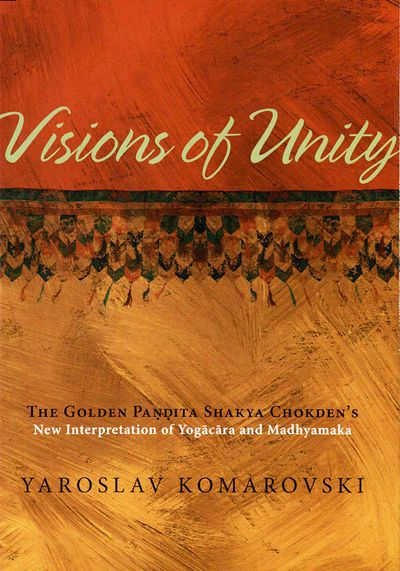Visions of Unity
< Books
| (4 intermediate revisions by one other user not shown) | |||
| Line 1: | Line 1: | ||
{{Book | {{Book | ||
|BookPerson={{Book-person | |BookPerson={{Book-person | ||
| + | |PersonPage=ShAkya mchog ldan | ||
| + | |PersonName=Shakya Chokden | ||
| + | }}{{Book-person | ||
|PersonPage=Komarovski, Y. | |PersonPage=Komarovski, Y. | ||
|PersonName=Yaroslav Komarovski | |PersonName=Yaroslav Komarovski | ||
| − | |||
| − | |||
| − | |||
}} | }} | ||
|FullTextRead=No | |FullTextRead=No | ||
| Line 29: | Line 29: | ||
***{{i|''Topical Divisions of Shakya Chokden's Works Addressed in This Book'' |59 }} | ***{{i|''Topical Divisions of Shakya Chokden's Works Addressed in This Book'' |59 }} | ||
| − | *{{i|Chapter Two: The Intellectual Background of Shakya Chokden's Interpretation of Yogācāra and Madhyamaka |71 }} | + | *{{i|Chapter Two: The Intellectual Background<br>of Shakya Chokden's Interpretation of Yogācāra and Madhyamaka |71 }} |
**{{i|1. Two Tendencies in Yogācāra and Niḥsvabhāvavāda Writings |71 }} | **{{i|1. Two Tendencies in Yogācāra and Niḥsvabhāvavāda Writings |71 }} | ||
**{{i|2. Basic Elements of Shakya Chokden's Approach to Mahāyāna Systems |84 }} | **{{i|2. Basic Elements of Shakya Chokden's Approach to Mahāyāna Systems |84 }} | ||
| Line 37: | Line 37: | ||
*{{i|Chapter Three: Readjusting Rungs of the Ladder: Revisiting Doxographical Hierarchies| 109 }} | *{{i|Chapter Three: Readjusting Rungs of the Ladder: Revisiting Doxographical Hierarchies| 109 }} | ||
**{{i|1. Key Features of Shakya Chokden's Approach to the Buddhist Tenets |109 }} | **{{i|1. Key Features of Shakya Chokden's Approach to the Buddhist Tenets |109 }} | ||
| − | **{{i|2. Demarcating the Middle: On the Valid Divisions of Madhyamaka and Great Madhyamaka |116 }} | + | **{{i|2. Demarcating the Middle: On the Valid Divisions of Madhyamaka and<br>Great Madhyamaka |116 }} |
**{{i|3. Self-Emptiness and Other-Emptiness |122 }} | **{{i|3. Self-Emptiness and Other-Emptiness |122 }} | ||
***{{i|''Self-Emptiness'' |124 }} | ***{{i|''Self-Emptiness'' |124 }} | ||
| Line 50: | Line 50: | ||
**{{i|2. The Heart of the Matter: Probing the Alīkākāravāda/ Niḥsvabhāvavāda Distinction |168}} | **{{i|2. The Heart of the Matter: Probing the Alīkākāravāda/ Niḥsvabhāvavāda Distinction |168}} | ||
**{{i|3. A New Look at the Old Origins: Distinctions of Madhyamaka Stemming<br>from Interpretations of the Second and Third Dharmacakras |183}} | **{{i|3. A New Look at the Old Origins: Distinctions of Madhyamaka Stemming<br>from Interpretations of the Second and Third Dharmacakras |183}} | ||
| − | ***{{i|''Looking at the Second and Third Dharmacakras through the Eyes of the Madhyamaka Founders'' |183}} | + | ***{{i|''Looking at the Second and Third Dharmacakras through the Eyes of the<br>Madhyamaka Founders'' |183}} |
***{{i|''Position of Alīkākāravāda'' |186}} | ***{{i|''Position of Alīkākāravāda'' |186}} | ||
***{{i|''Position of Niḥsvabhāvavāda'' |191}} | ***{{i|''Position of Niḥsvabhāvavāda'' |191}} | ||
| Line 57: | Line 57: | ||
*{{i|Chapter Five: Explorations in Empty Luminosity: Shakya Chokden's Position on Primordial Mind |213}} | *{{i|Chapter Five: Explorations in Empty Luminosity: Shakya Chokden's Position on Primordial Mind |213}} | ||
| − | + | **{{i|1. Facing the Reality of Primordial Mind |213}} | |
***{{i|''Primordial Mind and the Question of Existence'' |213}} | ***{{i|''Primordial Mind and the Question of Existence'' |213}} | ||
***{{i|''The Question of Withstanding Analysis'' |220}} | ***{{i|''The Question of Withstanding Analysis'' |220}} | ||
***{{i|''Does True Existence Have to Be Negated in Order to Abandon Grasping at It?'' |223}} | ***{{i|''Does True Existence Have to Be Negated in Order to Abandon Grasping at It?'' |223}} | ||
**{{i|2. Primordial Mind as an Impermanent Phenomenon |228}} | **{{i|2. Primordial Mind as an Impermanent Phenomenon |228}} | ||
| − | **{{i|3. (Un)linking the Self-Cognizing Primordial Mind and Dualistic Consciousness |238}} | + | **{{i|3. (Un)linking the Self-Cognizing Primordial Mind and Dualistic<br>Consciousness |238}} |
**{{i|4. Does Self-Cognition Cognize Itself? |242}} | **{{i|4. Does Self-Cognition Cognize Itself? |242}} | ||
**{{i|5. Primordial Mind as the Bridge between Yogācāra and Tantra |249}} | **{{i|5. Primordial Mind as the Bridge between Yogācāra and Tantra |249}} | ||
| Line 80: | Line 80: | ||
*{{i|Index|423}} | *{{i|Index|423}} | ||
| − | |||
|PostStatus=Needs Final Review | |PostStatus=Needs Final Review | ||
|StopPersonRedirects=No | |StopPersonRedirects=No | ||
| + | |AddRelatedTab=No | ||
|BookParentPage=Research/Secondary Sources | |BookParentPage=Research/Secondary Sources | ||
}} | }} | ||
Latest revision as of 18:21, 9 November 2021
A detailed study of controversial Tibetan Buddhist thinker Śākya Chokden, a fifteenth-century Sakya philosopher who wrote extensively on Yogācāra and Madhyamaka in an attempt to synthesize the two, this book presents Yaroslav Komarovski's dissertation research. Komarovski skillfully places Śākya Chokden in a long history of Yogācāra-Madhyamaka syntheses, a tradition that Śākya Chokden accused Tsongkhapa of abandoning in his radical interpretation of Candrakīrti and rejection of all positive-language doctrine. Although his writings were recognized for their brilliance, his criticisms of Tsongkhapa and Sakya Paṇḍita, and his qualified acceptance of "other-emptiness" (gzhan stong), meant that he was almost entirely rejected by his peers. In dense but readable prose Komarovski explains how Śākya Chokden reclassified elements of each (the Satyākāravāda doctrine of the Yogācāra, and the Prasaṅgika branch of the Madhyamaka) as true Madhyamaka; each was capable of bringing people to a realization of the ultimate, one with positive language and the other with negative.
| Citation | Komarovski, Yaroslav. Visions of Unity: The Golden Paṇḍita Shakya Chokden's New Interpretation of Yogācāra and Madhyamaka. Albany: State University of New York Press, 2011. |
|---|---|


